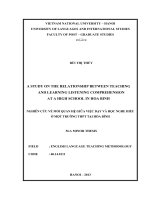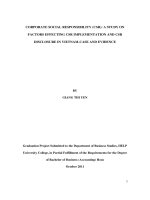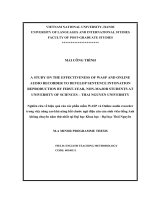A study on fe induced structural, magnetic and transport properties in colossal magnetoresistive nd0 67sr0 33mno3 polycrystalline bulk and films 4
Bạn đang xem bản rút gọn của tài liệu. Xem và tải ngay bản đầy đủ của tài liệu tại đây (413.24 KB, 18 trang )
Chapter Four: Temperature Sintering Effects in La
0.67
Sr
0.33
MnO
3
/Nd
0.67
Sr
0.33
MnO
3
4 Temperature Sintering Effects on the Magnetic, Electrical and
Transport Properties of La
0.67
Sr
0.33
MnO
3
/Nd
0.67
Sr
0.33
MnO
3
Composites
4.1 Introduction
Magnetoresistance, MR effect as defined in Chapter 3 has widely been observed
in ferromagnetic metals [128 - 130], heterogeneous magnetic alloys [131] and manganites
[132, 75] systems. The MR effect consists of both intrinsic intragranular and a non-
intrinsic intergranular effects. Examples of the former include anisotropic
magnetoresistance (AMR) of permalloy [133], the colossal magnetoresistance (CMR) of
EuO [134] and mixed-valence manganites [132, 75] of the doped perovskite structure, A
1-
x
B
x
MnO
3
where A is a trivalent ion and B is a divalent ion. Examples of the latter are the
giant magnetoresistance (GMR) of magnetic bimetallic and multimetallic layers in Fe-Cr
or Co-Cu [16, 19] and ferromagnetic granules dispersed in paramagnetic metal films
[135, 136]. In short, the different types of magnetoresistance effects depend on the
changes of the adjacent angles between the magnetization of the neighboring grains with
the direction of the applied magnetic field. The intrinsic intragranular MR effect that is
observed in the manganite system can be tuned by doping either at the A or Mn sites [52,
137]. It is usually observed under high field within a narrow temperature range near the
vicinity of the magnetic transition temperature. On the other hand, it is proposed that the
intergranular effect that responds to low field is attributed to the spin polarized
transportation of conduction electrons between grains to grains [52, 51]. It is this
mechanism that has a major importance in potential field-sensor and magnetic recording
88
Chapter Four: Temperature Sintering Effects in La
0.67
Sr
0.33
MnO
3
/Nd
0.67
Sr
0.33
MnO
3
device applications. In order to have a better understanding and control of this
mechanism, a number of research groups have come up with elegant and useful
experiments to understand the origins of the MR effects. A direct study of the properties
of grain boundaries on the MR effects has been done by growing well-controlled
La
2/3
Sr
1/3
MnO
3
(LSMO) films on bicrystalline SrTiO
3
substrates at various specific
angles [138]. The study has conclusively shown that MR was related to the interfaces
created at the bicrystal junction. Hwang et al. [52] have also demonstrated that the
observed MR at low field in La
2/3
Sr
1/3
MnO
3
was due to spin-dependent tunneling
between grains. Other observation of magnetoresistance in tunneling-type structures,
such as heterogeneous magnetic alloys with ferromagnetic grains embedded in
immiscible insulating matrix such as Ni/SiO
2
and Co/SiO
2
[139] have provided further
evidence on the manifestation of conduction electrons spin-dependent scattering
dependence on the local magnetic configuration. The macroscopic properties of metal-
insulator mixtures depend on the variable metallic volume fraction x. At low x values,
metallic grains are isolated from each other and an electric transport is realized by
intergranular tunneling or temperature activated hopping. When the metal concentration
is increased above a certain threshold, individual grains form an infinite cluster with a
continuous metallic conductance path. Besides the examples given above, MR can also
be enhanced with high spin polarized, half-metallic ferromagnetic (FM) manganite
material. It is found to be the best candidate for maximizing spin-polarization dependent
devices due to the unique nature of double exchange mediated ferromagnetism results in
completely polarized conduction electrons in FM state. Examples of such granular
ferromagnetic manganite combinations have already been reported in
89
Chapter Four: Temperature Sintering Effects in La
0.67
Sr
0.33
MnO
3
/Nd
0.67
Sr
0.33
MnO
3
La
0.67
Sr
0.33
MnO
3
/CeO
2
[62], La
0.7
Ca
0.3
MnO
3
-Ag [140], La
0.7
Sr
0.3
MnO
3
-Pr
0.5
Sr
0.5
MnO
3
[141], and La
0.67
Ca
0.33
MnO
3
-Al
2
O
3
[142] composites. The incorporation of a second
phase, usually a nonmagnetic or an antiferromangetic (AFM) insulator (I) into the FM
manganite matrix can modify the magnetic scattering and hence the electron tunneling
probability at the grain boundaries.
In this chapter, we report the results of the microstructure, magnetic and
electrotransport properties of a composite system, which consists of two half-metallic
ferromagnetic manganese oxides, La
0.67
Sr
0.33
MnO
3
(LSMO) and Nd
0.67
Sr
0.33
MnO
3
(NSMO). Here, instead of using FM/I type composites, a double soft ferromagnetic metal
(FMM), FM/FM type composite was synthesized. In order to elucidate the relative
importance of grain boundary in respect of the electrical transport properties, a
comparative study is carried out by varying the sintering temperature of the composite
while keeping the doping concentration of the second phase constant. By doing this, we
hope to see an improved temperature dependence of MR, especially near room
temperature. Early criticisms about the technological relevance of the manganites were
due to the fact that the field induced MR was limited to a narrow temperature range and
the rapid decrease of MR with increasing temperature makes them unacceptable for any
real field sensing device. Optimal conditions for achieving broad CMR responses across
room temperature by tuning the sintering temperature of a composite are observed and
reported here and it can be viewed as a promising route to technologically important
advances. LSMO and NSMO with Curie temperatures, T
c
= 380 K and 270 K,
respectively, are used. The measured magnetic moment of LSMO is 3.67 µ
B
per formula
unit [8] while that of NSMO is 4.2 µ
B
per formula unit [95] at 5 K. The coercivities of
90
Chapter Four: Temperature Sintering Effects in La
0.67
Sr
0.33
MnO
3
/Nd
0.67
Sr
0.33
MnO
3
LSMO and NSMO from the measured M-H hysteresis at 78 K are H
cLSMO
≈ 80 Oe and
H
cNSMO
≈ 350 Oe, respectively. With the combination of these materials, no increase in
resistance to a few orders of magnitude of the composites is observed as was reported by
other FM/I type synthesized composites. A high resistivity is known to make the
application of the materials incompatible for practical devices.
4.2 Experiments
La
0.67
Sr
0.33
MnO
3
/Nd
0.67
Sr
0.33
MnO
3
(LSMO/NSMO) composites are prepared in
two steps. First, NSMO and LSMO powders are prepared by solid-state reaction method.
The detailed preparation process has been described in Chapter Two. The obtained
products are then mixed in equal weight ratio and carefully ground in an agate mortar.
Next, the mixed powders are pressed into pellets and finally calcined for 5 h in air at
three different sintering temperatures, T
s
= 900, 1100 and 1300
°
C to achieve the desired
compositions. The sample phases are determined by a fine-step-mode x-ray diffraction
(XRD), model Phillips Diffractometer with Cu Kα source. High-resolution scanning
electron microscopy (SEM) equipped with energy dispersive x-ray analysis (EDX) has
been employed to check the crystallinity, microstructures and constitution of the samples.
An Oxford superconducting vibrating sample magnetometer (VSM) and a standard four-
pad technique are used to evaluate the magnetic property and electrical resistivity with
and without external magnetic field, H of the samples.
91
Chapter Four: Temperature Sintering Effects in La
0.67
Sr
0.33
MnO
3
/Nd
0.67
Sr
0.33
MnO
3
Figure 4 - 1 XRD patterns for NSMO, LSMO and a series of composites at different
sintering temperatures, T
s
= 900, 1100 and 1300
°
C. The inset gives the selected range of
57
°
≤ 2θ ≤ 60
°
for the above five samples.
92
Chapter Four: Temperature Sintering Effects in La
0.67
Sr
0.33
MnO
3
/Nd
0.67
Sr
0.33
MnO
3
4.3 Experimental Results and Discussions
4.3.1 Structural Characterization
Figure 4 - 1 below shows the XRD patterns of LSMO, NSMO and a series of
LSMO/NSMO composites at different sintering temperatures, T
s
= 900, 1100 and 1300
°
C. LSMO and NSMO samples are polycrystalline without any preferred orientation and
the sintering temperature is sufficiently high to obtain a single-phase perovskite. All the
reflection lines for the parent LSMO and NSMO samples are successfully indexed with
an orthorhombic structure (space group Pnma) ABO
3
-type distorted perovskite structure.
For the LSMO/NSMO composites, the diffraction peaks caused by the individual parent
samples are indistinguishable from each other. Thus, an inset which shows the selected
range of 57
°
≤ 2θ ≤ 60
°
has been included. As seen in figure 4 - 1 above, the peak for the
composite sintered at 900
°
C is well represented by combination of LSMO and NSMO. It
can be interpreted as having two phases of LSMO and NSMO coexisting in the
composite. Upon increasing the sintering temperature up to 1300
°
C, the individual peaks
of LSMO and NSMO coalesce and broaden. To further confirm the dependence of
microstructure on the sintering temperature, the surface morphologies of LSMO, NSMO
and LSMO/NSMO composites at T
s
= 900, 1100 and 1300
°
C have been imaged by high-
resolution scanning electron microscopy (SEM). As can be seen in figure 4 - 2 below,
LSMO has smaller grains than NSMO. The average grain size for LSMO is in the range
of 1 - 5 µm while that of NSMO is 5 - 10 µm. The SEM image for composite sintered at
T
s
= 900
°
C shows that larger NSMO particles are well separated by smaller LSMO
grains. When the composite was sintered at 1100
°
C, the LSMO and NSMO particles do
not seem to connect tightly, differing from its parent samples. At T
s
= 1300
°
C, the
93
Chapter Four: Temperature Sintering Effects in La
0.67
Sr
0.33
MnO
3
/Nd
0.67
Sr
0.33
MnO
3
Figure 4 - 2 SEM morphologies of NSMO, LSMO and LSMO/NSMO composites of
T
s
= 900, 1100 and 1300
°
C.
94
Chapter Four: Temperature Sintering Effects in La
0.67
Sr
0.33
MnO
3
/Nd
0.67
Sr
0.33
MnO
3
composite has well-formed granular crystallites with grain size comparable or larger than
the parent samples. By looking at the SEM images, we do not exclude the possibility that
high temperature sintering helps to promote the growth of intermediate phase of La
0.67(1-
x
)
Nd
0.67
x
Sr
0.33
MnO
3
in the composite due to the interfacial diffusion reaction between the
LSMO and NSMO grain boundaries.
4.3.2 Magnetic Properties
Figure 4 - 3 presents the temperature dependence of magnetization, M(T) at H =
200 Oe for LSMO, NSMO and LSMO/NSMO composites of T
s
= 900, 1100 and 1300
°
C.
As is seen, pure LSMO is in the FM state over the whole measured temperature range
while pure NSMO begins to transit from paramagnetic to FM at T
c
(defined as the
temperature where dM(T)/dT is minimum) ≈ 270 K. The composites of T
s
= 900 and 1100
°
C exhibit two distinct transitions originating from NSMO and LSMO samples. At T
s
=
1300
°
C, the macroscopic magnetization curve revealed an additional phase with T
c
≈ 320
K, as shown in the inset to figure 4 - 3, besides its parent LSMO and NSMO samples.
From the VSM data, we can conclude that high temperature sintering in the composite of
T
s
= 1300
°
C brings about the formation of (La
1-
x
Nd
x
)
0.67
Sr
0.33
MnO
3
phase as the
magnetization curve reveals the gradual diminishing phase of its parent LSMO and
NSMO samples. Our result was further compared with the polycrystalline sample (La
1-
x
Nd
x
)
0.7
Sr
0.3
MnO
3
as reported by Wu et al. [143]. According to Wu et al., the bulk
samples with x = 0.25 ∼ 0.5 prepared under similar method and conditions have transition
temperatures at around 310 to 340 K. These seem to be consistent with our results
95
Chapter Four: Temperature Sintering Effects in La
0.67
Sr
0.33
MnO
3
/Nd
0.67
Sr
0.33
MnO
3
Figure 4 - 3 Temperature dependence of magnetization, M(T) for NSMO, LSMO and
LSMO/NSMO composites at different T
s
of 900, 1100 and 1300
°
C. The inset shows the
temperature dependence of dM/dT for composite sintered at T
s
= 1300
°
C.
96
Chapter Four: Temperature Sintering Effects in La
0.67
Sr
0.33
MnO
3
/Nd
0.67
Sr
0.33
MnO
3
reported above, indicating the existence of (La
1-
x
Nd
x
)
0.7
Sr
0.3
MnO
3
phase in highly
sintered composites. In order to get a better insight into the enhanced boundary effect
caused by the interfacial phase, the field dependence of magnetization, M(H) for typical
samples with LSMO, NSMO and LSMO/NSMO composites of T
s
= 900, 1100 and 1300
°
C is measured at 78 K. This is done to avoid the variation due to magnetic domain
rotation taken at lower magnetic field of 200 Oe. It is obvious that there is a distinctive
difference in the magnitude of magnetization of the composites as shown in figure 4 - 4.
The composites of T
s
= 1100 and 1300
°
C have magnetization greater than their parent
samples. The red solid curve shows the as-calculated M(H) for LSMO/NSMO composite
according to the magnetization of parent LSMO and NSMO weight fractions in the
composite and is inserted for a comparison. The experimental curve for composite of T
s
=
900
°
C is very similar to the as-calculated M(H) curve except the latter is higher in
magnetization than the former. This difference suggests the non-parallel spin coupling
between the adjacent LSMO and NSMO particles in the absence of applied magnetic
field. The enhanced spin disorders at the grain boundary interfaces act as extra energy
barriers for the field to overcome in order to align the disordered Mn spins along the field
direction. Assuming that at 78 K, though both NSMO and LSMO layers in T
s
= 900
°
C
are in the FM state and no interdiffusion occurs across the LSMO and NSMO grain
boundaries, some spins near and inside the LSMO and NSMO boundary layers may still
be disorientated, resulting in a more random distribution of grain magnetization. Figure 4
- 4 shows the field dependence of magnetic moments per unit formula at 78 K. LSMO
sample has a value of M close to the theoretical limit (∼3.67 µ
B
) based on spin-only
97
Chapter Four: Temperature Sintering Effects in La
0.67
Sr
0.33
MnO
3
/Nd
0.67
Sr
0.33
MnO
3
0
10
20
30
40
50
60
70
80
90
100
02468
Applied Field, H (T)
Magnetization, M (emu/g)
0
0.5
1
1.5
2
2.5
3
3.5
4
M (m
B
/formula unit
)
LSMO
L5N5900
L5N51100
L5N51300
NSMO
Calculated
LSMO/NSMO
Figure 4 - 4 Field dependence of magnetization, M(T) and the secondary axis shows
the field dependence of magnetic moments per unit formula for NSMO, LSMO and
LSMO/NSMO composites at different T
s
of 900, 1100 and 1300
°
C. The red solid curve
represents the calculated M(H) according to the weight fraction of LSMO and NSMO
assuming no interaction reaction occurs between them.
98
Chapter Four: Temperature Sintering Effects in La
0.67
Sr
0.33
MnO
3
/Nd
0.67
Sr
0.33
MnO
3
contributions from all Mn ions. However, the magnetic moment of NSMO reaches only
3.4 µ
B
at 6 T. This shows that at 78 K, some of the Mn and Nd spins in NSMO sample do
not align ferromagnetically with each other. This agrees well with the hypothesis made
earlier. As a small field is applied, most spins realign themselves readily parallel to each
other where the overall spins in the near boundary layers tend to point in the same
direction. Hence the embedding of LSMO into NSMO particles introduces additional
magnetic disorder at the grain boundary layers, leading to lower magnetization than the
as-calculated M(H) curve. It is observed that composite of T
s
= 1100
°
C has the highest
magnetization among the three composites. This is because at T
s
= 1100
°
C the composite
is in weaker connectivity than the composite of T
s
= 1300
°
C, resulting in the easier
overall magnetic domain rotation. The result coincides with M(T) curve seen in figure 4 -
3 even when the magnetic field is still low. Based on figure 4 - 4, we can conclude that
the presence of interfacial diffusion between the LSMO and NSMO grains in composites
with T
s
= 1100 and 1300 °C. The higher magnetization values for composites with T
s
=
1100 and 1300 °C than their parents and composite of T
s
= 900 °C samples, as seen in
figure 4 - 4, were attributed to interfacial diffusion across the grain boundaries during
sample sintering, in addition to the contribution from non-parallel spin coupling. Thus,
the interfacial diffusion reaction has also induced the formation of (La
1-
x
Nd
x
)
0.67
Sr
0.33
MnO
3
phase near the grain boundaries as seen in the SEM image. This
phase should be in the FMM state as shown in inset to figure 4 - 3. Hence, it will be
easier to align the spins along the field direction giving rise to higher magnetization
value. At T
s
= 1300
°
C, however, the composite appears to be dominated by (La
1-
x
Nd
x
)
0.67
Sr
0.33
MnO
3
phase. Thus, the magnetization curve displays property intrinsic to
99
Chapter Four: Temperature Sintering Effects in La
0.67
Sr
0.33
MnO
3
/Nd
0.67
Sr
0.33
MnO
3
this phase. Therefore, the growth of an interfacial phase near grain boundaries and the
coexistence of multiphase due to high sintering temperature have a direct effect on the
microstructure and magnetic properties in these composites.
The magnetic interactions between LSMO and NSMO grains can also be
explained by observing the magnetic hysteresis loop in figure 4 - 5. Assuming that no
interlayer exchange coupling occurs between the two phases, then a two-step switching
of hysteresis magnetic loop resembling one for the La
0.5
Sr
0.5
CoO
3-δ
/La
0.5
Sr
0.5
MO
3-δ
multilayers [144] (one at H
cLSMO
and another at H
cNSMO
) as shown in figure 4 - 5, is
expected for LSMO/NSMO composites. However, the composites with T
s
= 900, 1100
and 1300 °C show a continuous switching with an overall H
c
of ∼ 100 – 500 Oe,
indicating an interlayer exchange coupling between grains in the composites.
Man
g
etic moment
,
m
M
s1
×V
1
+ M
s2
×V
2
M
s1
×V
1
- M
s2
×V
2
Magnetic field, H
H
cLSMO
H
cNSMO
Figure 4 - 5 Schematic drawing of hysteresis for LSMO/NSMO without exchange
coupling.
100
Chapter Four: Temperature Sintering Effects in La
0.67
Sr
0.33
MnO
3
/Nd
0.67
Sr
0.33
MnO
3
4.3.4 Electro- and Magneto-transport Properties
Figure 4 - 6 and 4 - 7 show the temperature dependent resistivity and MR curves
at H = 0 and 10 kOe applied field for all samples. According to equation (3 - 1), MR is
defined [ρ(H = 0) - ρ(H = 10 kOe)]/ ρ(H = 0), where ρ(H = 0) is the zero-field resistivity
and ρ(H = 10 kOe) is the resistivity in the 10 kOe applied field, respectively. At T
s
= 900
°C, the composite has an insulator-metal transition temperature, T
p
≈ 268 K, originating
primarily from its parent NSMO component. This result further confirms the hypothesis
made earlier that two phases from its parent samples coexist in the lowest T
s
composite.
Composites of T
s
= 1100 and 1300 °C exhibit lower T
p
≈ 255 K and the resistivity
continues to increase with increasing temperature unlike those from its parents and T
s
=
900 °C samples. The lower T
p
in these samples than that of the parent NSMO sample
indicates the extrinsic transport behavior originating from interfaces and grain boundary
effects. As seen in the SEM morphologies of figure 4 – 2, the grain boundaries in T
p
=
1100 °C are not clear and there is a short neck between two grains whereas for T
s
= 1300
°C, the grain boundaries are obvious and the necks among the grains disappear. Thus the
distortion at grain boundaries which indirectly affect the inside of the grains may result in
the disparity between the as-observed T
p
and T
c
[25]. It is observed that the resistivity in
the composites decreases with increasing sintering temperature. The resistivities as at
room temperature were 0.0012, 0.0015, 0.0022, 0.0013 and 0.0005 Ωcm
-1
for LSMO,
NSMO, LSMO/NSMO composites at T
s
= 900, 1100 and 1300 °C, respectively.
Composite sintered at T
s
= 900 °C has the highest resistivity among the three composites
101
Chapter Four: Temperature Sintering Effects in La
0.67
Sr
0.33
MnO
3
/Nd
0.67
Sr
0.33
MnO
3
0
0.001
0.002
0.003
0.004
0.005
0.006
0.007
0.008
0.009
0.01
70 170 270 370
Temperature, T (K)
Resistivity,
ρ
(Ohm-cm)
LSMO
NSMO
900
o
C
1100
o
C
1300
o
C
Figure 4 - 6 Temperature dependence of resistivity at zero field for LSMO (yellow),
NSMO (purple) and LSMO/NSMO composites of T
s
= 900 (green), 1100 (blue) and 1300
(black)
o
C.
102
Chapter Four: Temperature Sintering Effects in La
0.67
Sr
0.33
MnO
3
/Nd
0.67
Sr
0.33
MnO
3
due to the enhanced spin dependent interfacial disorder created at the neighboring grain
boundaries, since the current flow is controlled by the relative orientation θ
ij
of the
magnetization of the adjacent neighbors. Thus, the distorted or bent Mn-O-Mn path and
the misaligned magnetic spins decrease the conductivity in the composite by hindering
the tunneling of electrons from one place to another. The applied magnetic field of 10
kOe polarizes parts of the disordered Mn spins inside the coupling layers along the
direction of the field. Therefore, it has the highest MR among the three composites. The
MR
max
for the corresponding LSMO, NSMO, LSMO/NSMO composites of T
s
= 900,
1100 and 1300 °C are ∼13% at the temperature where MR is maximum, T
max
≈ 365 K,
34% at T
max
≈ 268 K, 26% at T
max
≈ 260 K, 18% at T
max
≈ 250 K and 13% at T
max
≈ 245
K, respectively. Interestingly, the MR near room-temperature decreases rapidly in
NSMO, LSMO samples and composites at T
s
= 900 and 1100 °C, whereas a rather
constant MR was observed near room-temperature for composite at T
s
= 1300 °C. This
observation of broad MR around room-temperature can most likely be ascribed to the
coexistence of multiphase in the composite of T
s
= 1300 °C, which may be useful from a
technological perspective.
103
Chapter Four: Temperature Sintering Effects in La
0.67
Sr
0.33
MnO
3
/Nd
0.67
Sr
0.33
MnO
3
Figure 4 - 7 Temperature dependence of MR ratios for LSMO (yellow), NSMO
(purple) and LSMO/NSMO composites of T
s
= 900 (green), 1100 (blue) and 1300 (black)
o
C.
104
Chapter Four: Temperature Sintering Effects in La
0.67
Sr
0.33
MnO
3
/Nd
0.67
Sr
0.33
MnO
3
4.4 Conclusions
In summary, the microstructure, magnetic and electrical transport properties of
NSMO/LSMO composites at various sintering temperatures, T
s
, have been investigated.
It is shown that sintering temperature plays an important role in affecting the
microstructure and interfacial reaction at the grain boundary interfaces. Composite
sintered at T
s
= 900 °C has the highest MR among the three composites. This observation
can be ascribed to the distorted or bent Mn – O – Mn path and enhanced magnetic spin
disorder occuring across the neighboring grains. The probability of electron tunneling
from one ferromagnetic grain to another ferromagnetic grain depends on the relative
orientation between moments of the two grains. The applied magnetic field suppresses
the spin fluctuations and thus the probability of spin tunneling across grain boundaries
increases. With the coexistence of multiphase in T
s
= 1300 °C composite, broad
magnetoresistance around room temperature is obtained. The results strongly suggest that
the sintering temperature has a great effect on the properties of the grain boundary in the
composites.
105


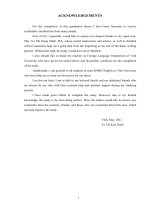
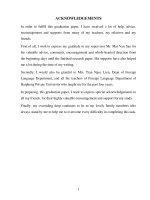
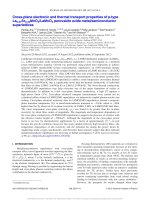
![gherghina et al - 2014 - a study on the relationship between cgr and company value - empirical evidence for s&p [cgs-iss]](https://media.store123doc.com/images/document/2015_01/02/medium_JKXoRwVO1T.jpg)
